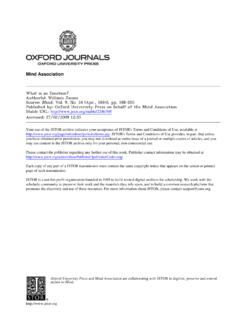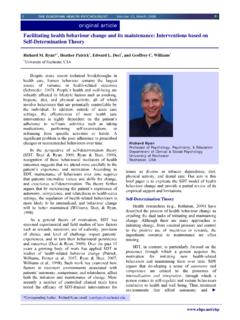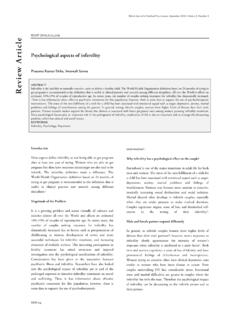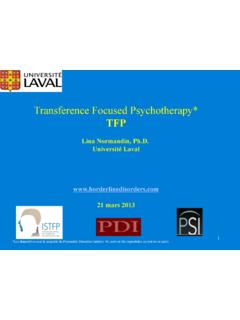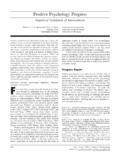Transcription of When Trying Is Not Enough: Emotion Regulation and the ...
1 Emotion 2012 American Psychological Association 2012, Vol. 12, No. 5, 997 1003 1528-3542/12/$ DOI: When Trying Is Not Enough: Emotion Regulation and the Effort Success Gap in Bipolar Disorder June Gruber Allison G. Harvey Yale University University of California, Berkeley James J. Gross Stanford University Bipolar disorder (BD) is presumed to involve difficulties in Emotion Regulation . Little is known, however, about the specific Emotion Regulation profile associated with this disorder. The present study examined the use of specific Emotion Regulation strategies among individuals with BD (n ! 37) and healthy controls (n ! 38). Participants' spontaneous use of reappraisal and suppression, as well as their associated effort and success at regulating their emotions, was measured in the context of three emotionally evocative films (neutral, happy, sad). Results indicated that the BD participants made greater use of spontaneous suppression and reappraisal across all films compared to the control group.
2 BD. participants also reported greater effort, but less success, when spontaneously regulating emotions. These findings suggest that bipolar disorder is associated with less success when regulating emotions despite a widespread engagement of regulatory efforts. Discussion focuses on the disjunction between troubled Emotion functioning in bipolar disorder and sustained efforts to modify intense emotions. Keywords: bipolar disorder, Emotion Regulation , reappraisal, suppression Bipolar disorder (BD) is characterized by disrupted emotional Thompson, 2007). In order to examine how Emotion Regulation functioning, including periods of abnormally and persistently ele- goes awry in bipolar disorder, it is useful to test a guiding con- vated mood or mania, depressed mood and anhedonia, and mixed ceptual framework. We adopt a process model of Emotion regula- states with co-occurring mania and depression (American Psychi- tion proposed by Gross (1998), which illustrates several Emotion atric Association, 2000).
3 Consistent with these clinical descrip- Regulation strategies that can be used to increase or decrease the tions, models of bipolar disorder have stressed the importance of intensity of positive and negative emotions at different stages in troubled Emotion Regulation ( , Johnson, Gruber, & Eisner, the Emotion generative process. Following this framework, some 2007; Gruber, 2011; Phillips & Vieta, 2007). Few empirical stud- strategies appear to be relatively more adaptive than other strate- ies, however, have provided empirical evidence for an Emotion gies. dysregulation view of bipolar disorder. Furthermore, Emotion reg- One widely discussed example of a generally adaptive strategy ulation encompasses different processes that occur at different is cognitive reappraisal (or reappraisal ; example: I control my times, making it difficult to pinpoint precisely how Emotion dys- emotions by changing the way I think about the situation I'm in ), Regulation relates to bipolar disorder (Ehring, Tuschen-Caffier, defined as construing an Emotion -eliciting situation in such a way Schnulle, Fischer, & Gross, 2010; Gross & Thompson, 2007; that it alters its emotional impact (Gross, 1998).)
4 A cardinal exam- Lewis, Zinbarg, & Durbin, 2010). Accordingly, an important next ple of a generally maladaptive strategy is expressive suppression step is to specify which components of Emotion Regulation such (or suppression ; example: I keep my emotions to myself ), as the specific strategies implemented, the contexts in which they defined as a response-focused form of Emotion Regulation involv- are implemented, and the associated effort and success are im- ing the inhibition of Emotion -expressive behavior (Gross, 1998;. plicated in bipolar disorder. Gross & Levenson, 1997). Research on cognitive reappraisal has focused on the extent to Adaptive and Maladaptive Emotion Regulation which it preemptively influences emotional reactivity. Several Emotion Regulation refers to the processes by which individuals laboratory studies conducted in nonclinical samples indicate that consciously or unconsciously modify their emotions (Gross & cognitive reappraisal is associated with reduced emotional expe- rience and behavior ( , Gross, 1998) as well as decreased neural activity in the amygdala and insula ( , Ochsner & Gross, 2005).
5 This article was published Online First January 16, 2012. The self-reported frequency of cognitive reappraisal in daily life June Gruber, Department of Psychology, Yale University; Allison G. Harvey, Department of Psychology, University of California, Berkeley;. has been associated with decreased negative Emotion and in- James J. Gross, Department of Psychology, Stanford University. creased positive Emotion and well-being (Gross & John, 2003). Correspondence concerning this article should be addressed to June Research on expressive suppression has demonstrated that it is Gruber, Yale University, Box 208205, New Haven, CT 06520. associated with greater physiological activation when viewing E-mail: emotional stimuli ( , Gross, 1998). A higher self-reported fre- 997. 998 GRUBER, HARVEY, AND GROSS. quency of suppression in daily life has been associated with reasoned that BD subjects would report greater effort in regulating increased negative Emotion and decreased positive Emotion and positive and negative emotions, based upon models that posit well-being (Gross & John, 2003).
6 Exaggerated efforts to control internal affective states (Mansell, Both reappraisal and suppression have largely been assessed via Morrison, Reid, & Lowens, 2007). For success, we predicted that self-report measures at the trait level ( , one's daily life ; Gross BD subjects would report decreased success in regulating positive & John, 2003) or via experimental manipulations of reappraisal and negative emotions compared to controls ( , Johnson et al., and/or suppression ( , Gross & Thompson, 2007). Less work 2007). We predicted that these findings would still hold when has examined the spontaneous use of these strategies in response to controlling for baseline levels of subjective and behavioral emo- online emotions occurring in the present moment ( , how many tion reactivity. strategies are used in the moment; Egloff, Schmuckle, Schwerdt- feger, & Burns, 2006; Volokhov & Demaree, 2010). Such work Method has important implications for isolating processes involved in the onset and maintenance of clinical disorders generally (and bipolar disorder specifically) and refining therapeutic treatments.
7 Participants Participants were 37 persons diagnosed with BD Type I (n ! Emotion Regulation in Bipolar Disorder 34) or type II (n ! 3) who were currently interepisode ( , neither manic nor depressed),1 and 38 healthy controls who did not meet Studies to date provide suggestive evidence that people with BD current or past criteria for any Diagnostic and statistical manual of exhibit difficulties regulating positive and negative emotions. With mental disorders (DSM IV TR) Axis I disorder (American Psy- respect to positive emotions, BD participants exhibit heightened chiatric Association, 2000). Exclusion criteria included history of startle eyeblink magnitude during a 3- to 5-s period following the severe head trauma, stroke, neurological disease, and autoimmune removal of positive photos, whereas unipolar depressed and disorder, or current alcohol and/or substance abuse or dependence healthy controls do not exhibit this prolonged response (Forbes, in the past month. Demographic and clinical characteristics are Miller, Cohn, Fox, & Kovacs, 2005).
8 Second, both remitted BD listed in Table 1. patients and college students at risk for BD report sustained The average age at onset for the BD group was (" ). elevations in positive Emotion across varying stimuli contexts years, and average illness duration was (" ) years. The compared to controls (Farmer et al., 2006; Gruber et al., 2008). lifetime average of manic/hypomanic episodes for BD participants Third, BD participants tend to dwell on positive feelings and was (" ) and for major depressive episodes was (". thoughts following a positive life event, rather than spontaneously ). The average number of psychotropic medications for the BD. down-regulate, compared to unipolar depressed and control par- group was (" ), including lithium (n ! 7), anticonvul- ticipants (Johnson, McKenzie, & McMurrich, 2008). With respect sants (n ! 16), antidepressants (n ! 22), neuroleptics (n ! 12), to negative Emotion , findings suggest that BD subjects endorse benzodiazepines (n ! 4), and sedative-hypnotics (n !)
9 3). BD. ruminating about negative Emotion more than controls (Gruber, participants were not excluded on the basis of comorbid disorders Eidelman, Johnson, Smith, & Harvey, in press; Thomas, Knowles, (aside from current substance or alcohol use disorders) given that Tai, & Bentall, 2007) but at levels comparable to those with BD is commonly comorbid with other disorders ( , Kessler et unipolar depression (Johnson et al., 2008). Furthermore, Depue, al., 2005), though BD was the primary diagnosis. BD participants Kleiman, Davis, Hutchinson, and Krauss (1985) found that BD had an average of (" ) current Axis I comorbidities, spectrum participants exhibit higher cortisol levels 3 hr after a including panic disorder (n ! 2), agoraphobia (n ! 2), social stressful math task compared to controls. Despite these initial phobia (n ! 4), specific phobia (n ! 9), obsessive compulsive indications that BD is a disorder of Emotion Regulation , the precise disorder (n ! 2), posttraumatic stress disorder (n !
10 2), generalized nature of spontaneous Emotion Regulation is not well understood. anxiety disorder (n ! 7), hypochondriasis (n ! 1), pain disorder (n ! 1), and binge eating disorder (n ! 1). The Present Study The goal of the present study was to examine spontaneous Clinical Diagnosis and Symptoms Emotion Regulation in healthy participants versus those with BD. BD and CTL group status was confirmed using the Structured More specifically, we sought to assess (a) the particular Emotion Clinical Interview for DSM IV (SCID-IV; Spitzer, Williams, Gib- Regulation strategies associated with BD and (b) the effort and bon, & First, 1990) administered by trained clinical psychology success participants experienced when engaging in spontaneous doctoral students and postdoctoral fellows. Fifteen random audio- Emotion Regulation . tapes were rated by an independent reviewer and ratings matched For Emotion Regulation strategy use, we tested the hypothesis 100% (# ! ) of primary diagnoses ( , BD or CTL).
